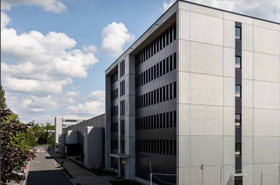The pandemic has induced a shift towards an always-on ‘new normal’ where everything from working to shopping to education to socialising is largely done online. This has fuelled the growth of data generation and, therefore, an increased need for digital infrastructure projects.
A cornerstone of this online way of life is data center infrastructure and investment in data centers in the UK and globally, a need that is likely to continue for years to come. Despite Brexit concerns, the UK has remained the largest market in Europe for colocation data centers, and London maintains its ambitions to lead as a world-leading digital hub.
But with the constraints of the more established data center locations in the UK, such as Slough and London Docklands, new development regions are emerging.
One such location is Dagenham in East London. Once an industrial center hosting factories belonging to Ford and other major manufacturers, the area’s regeneration is based on its burgeoning development into a film, media and digital technology hub.
But why did NTT select Dagenham, in particular, as the location for their UK expansion? Here are the five main reasons:
1. Secure, reliable and abundant power availability
According to IDC, “the amount of digital data created over the next five years will be greater than twice the amount of data created since the advent of digital storage.”
The enormous volumes of data generated means that organizations are under pressure to compute and store more information. The surge translates into the need for data center space and increased power to cope with the demand. Due to Dagenham’s history of automotive manufacturing and its location in East London, there is a legacy of strong power infrastructure provisioning. This means that data center operators can access a significant amount of high-availability energy supply with relative ease and without the long lead times (and costs) associated with new primary power connections.
2. Access to sustainable power
Environmental sustainability and renewable energy remain an important consideration. Dagenham’s focus on sustainability mirrors that of the responsibility businesses have in lessening the impact on the environment. It’s location at the heart of the Thames Gateway makes its energy strategy all the more crucial.
It’s essential that the growth to be experienced in the coming years must be paired with sustainability practices, so it doesn’t just lead to greater resource use and an increase in the city’s environmental footprint. This issue is addressed with the provisioning of energy through Beam Energy, Dagenham council’s energy provider. It provides electricity that is 100 percent renewable, sourced from UK-based wind and solar generators. Dagenham also has a plethora of district heating schemes enabling low-grade waste heat generators, such as data centers, to contribute to the local area and support more sustainable provisioning of heat to the local population.
3. Major support from the local authorities supporting Dagenham’s digital future
East London and the Thames Gateway have been identified as a ‘priority area’ for development. Dagenham lies in the heart of this region. It has already been recognised as a new hotspot for digital and knowledge-based industries. Soon, it will also become 'London's Hollywood' with the construction of new film studios.
This development is quickly establishing a reputation for Dagenham as a digital and media innovation hub. Strong engagement for this initiative by Barking and Dagenham Borough Council makes planning permission a collaborative process which can reduce the duration of data center development for a colocation provider.
4. Strong fibre connectivity back to London Docklands
Dagenham is within easy reach of Docklands, the UK’s internet hub and backbone for the global internet network that facilitates most of the London Internet Exchange’s (LINX) infrastructure, as well as a major global financial center. It’s also well situated for Shoreditch, which has become known as the ‘Silicon Roundabout,’ because of the cluster of high-tech companies located there. With more and more companies operating internationally and virtually, a strong connection to a global internet network is critical for seamless day-to-day business operations.
5. Abundance of land to allow for agile growth
London’s expansion eastward means that more than 400 hectares of land is available for development. Dagenham already has a proven track record for affordability and being a well-connected location. The scale of the transformation is huge with the borough offering new markets, new ideas and a range of investment opportunities with a large amount of brownfield land for development. Many of these brownfield locations are of significant size which allow great potential for uninhibited agile expansions of data center campuses.
More...
-

Take a look inside what hopes to be Britain's largest data center
The shell of NTT's new London data center is, frankly, hard to miss
-

Broadcast NTT London 1 Data Center Tour | Stream on-demand
Responding to future workload requirements in the heart of London's digital hub -

NTT details German data center expansion plans
Company adding some 30,000 sqm of space in country, a 40 percent increase


